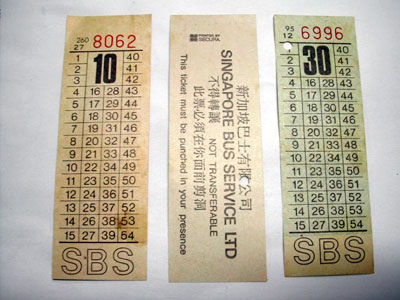From the form of public transport that breaks down a lot less, comes this nostalgic video of an old couple who spent most of their life taking the bus.
The video starts in the 60s, skips to the 80s/90s and finally concludes in modern day Singapore.
Watch it here:
Posted by Land Transport Authority – We Keep Your World Moving on 10 March 2016
Not only is it touching enough to make you forget all the times you waited 30 mins for a bus only to have three of them come together (I’m looking at you, Bus 99), they’re also a window into how we used to travel in these steel behemoths.
Take notes kids, this is how it was done.
Use tickets to practise your origami skills
 Image from here
Image from here
EZ-link cards might have made things easier for commuters, but they also killed a little of the romance of the bus ride – more precisely, the art of folding those bus tickets into tiny keepsakes.
Here’s how it goes: If you’re talented, go for the folded heart.
If you’re absolutely hopeless at life, just twist it up and turn it into a ring – like this.
Just don’t be disheartened when your bae rejects your proposal, though.
Why we don’t miss it: Cute, charming, even. But you’re killing trees. And knowing Singaporeans, our buses will probably be full of broken, abandoned hearts. Tragic.
Transitlink farecards – the father of ez-link
Singaporeans were spared the agony of carrying coins around everywhere when the magnetic Transitlink card came into operation. These flimsy cards were even slimmer than today’s EZ-link cards, but were also half as as efficient – you had to slot them into a machine, listen to weird noises made as it travelled through the system, and then collect it together with a paper ticket in hand.
Why we don’t miss it: Accidentally bend your transitlink card, and say goodbye to all that stored value.
Not knowing when your bus will arrive…
There was no app store in 1960, so you couldn’t download apps such as SG Buses or BusLeh or LTA's MyTransport App to help you manage your time better. Oh, there wasn’t a real-time bus information board also. Or any information of bus routes.
You just sat down and twiddled your thumbs until a bus came along. And you couldn’t even complain about the long wait on social media. Nasty.
Why we don’t miss it: Self-explanatory.
Fear the bus conductor
With everyone using EZ-link cards these days, it’s not easy to avoid paying the fare (not that you should – it comes with a hefty $50 penalty). All the bus driver needs to do is to count the number of beeps. One person, one beep.
But back in the day, buses were operated by a two-man team. The driver and the conductor, who were basically fare-Nazis, who would boot you off the bus if you couldn’t pay.
Bus conducting as a profession died in the 1980s, when coin payments took over. They were replaced by bus inspectors, who only occasionally board buses to check for fare evaders.
Why we don’t miss it: Does anyone ever love the bouncers at a club? Same reason.
Non-aircon buses
Guys, your mothers have gone through National Service, I kid you not. Very few buses had air-conditioning in the past – so she probably knows what it’s like to sit in an SAF 3-tonner.
Combined with Singapore’s tropical heat, these buses were sweltering at jams, and slightly more tolerable when moving. During monsoon season, seats closest to the windows would often be wet. Probably because those same windows could be incredibly difficult to close.
The good news was that you could probably dig a booger out of your nose and flick it out of the window. Poor motorcyclists.
The last non-air con bus keeled over and died in 2013. These hotboxes served hardened commuters such as NSmen, factory and foreign workers in Tuas – till the very end.
Why we don’t miss it: Put your hipster glasses aside and ask yourself. Would you rather ride in this to work every day?
Or this?
Enough said.
If you’re still alive and old enough to remember, what else do you remember about ancient public transport?
*This post fuels Mothership.sg so our writers don’t have to beg for a living (which is probably not allowed anyway.)










